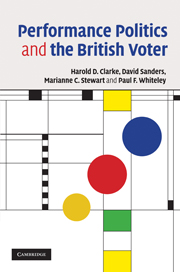Book contents
- Frontmatter
- Contents
- List of figures
- List of tables
- Acknowledgments
- 1 Performance politics and the British voter
- 2 The theory of valence politics
- 3 Valence politics and the long campaign
- 4 Tony's war
- 5 Electoral choices
- 6 The short campaign
- 7 Voting and political participation
- 8 Performance, people and the political system
- 9 Performance politics reconsidered
- Appendix A Vote in 2005 by socio-demographic characteristics
- Appendix B Turnout by socio-demographic characteristics
- Appendix C Dynamics of party identification
- Notes
- Bibliography
- Index
5 - Electoral choices
Published online by Cambridge University Press: 06 January 2010
- Frontmatter
- Contents
- List of figures
- List of tables
- Acknowledgments
- 1 Performance politics and the British voter
- 2 The theory of valence politics
- 3 Valence politics and the long campaign
- 4 Tony's war
- 5 Electoral choices
- 6 The short campaign
- 7 Voting and political participation
- 8 Performance, people and the political system
- 9 Performance politics reconsidered
- Appendix A Vote in 2005 by socio-demographic characteristics
- Appendix B Turnout by socio-demographic characteristics
- Appendix C Dynamics of party identification
- Notes
- Bibliography
- Index
Summary
This chapter analyses party choice and turnout in Britain's 2005 general election. As discussed in Chapters 3 and 4, the context in which this election was held differed from that of the 2001 general election. At that time, Labour was in a very strong position. The economy was vibrant, a sizable plurality of voters identified themselves as Labour partisans, and the issue agenda was dominated by public services such as the National Health Service and education, issues that Labour traditionally had claimed as its own. Labour leader Tony Blair, not especially popular, was more warmly received than his principal competitor, Conservative leader William Hague. However, by 2005, public opinion had shifted, and judgments about the performance of Prime Minister Blair and his New Labour government had become considerably more negative. In Blair's case, analyses presented in Chapter 4 have demonstrated that adverse public reactions to the continuing conflict in Iraq in the run–up to the 2005 election had done much to damage his image as a competent, trustworthy leader. Although the electoral system remained biased in Labour's favour, and most opinion polls showed the party holding a modest lead over the Conservatives, its 2005 electoral prospects were clearly more uncertain than they had been four years earlier. Labour would likely win more seats than its rivals, but a hung parliament was a real possibility.
In this chapter, we employ BES data to document the mix of public beliefs, attitudes and opinions that governed electoral choice in 2005. We then examine the explanatory power of rival models of party choice to understand the forces that affected voting behaviour in 2005.
- Type
- Chapter
- Information
- Performance Politics and the British Voter , pp. 143 - 191Publisher: Cambridge University PressPrint publication year: 2009

